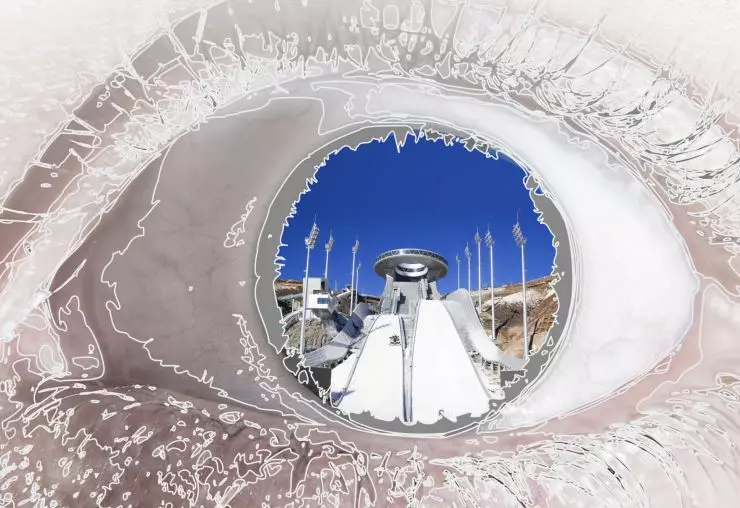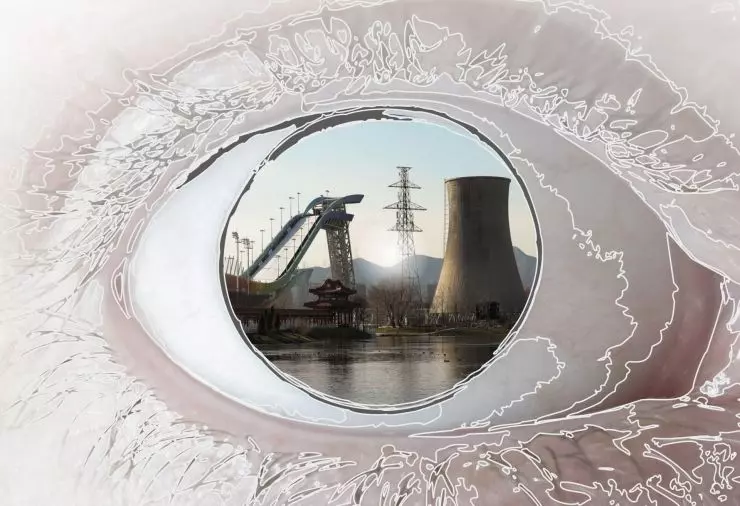And when he opened the second seal,
heard the second Animal saying:
"Come".
And out came another horse of the color of fire,
and sitting on it was given to take away peace from the earth,
so that people would kill each other -
and a great sword was given to him.
Rev. 6, 4 Pallotinum 1000th Anniversary Bible 1991
When I wrote a text for A&B two years ago about the beginning of the pandemic and the first lockdown, I used a passage from St. John's Revelation about the fourth horseman (Rev. 6:8) as an introduction. At the time, I had doubts about referring to St. John's Revelation as too catastrophic and no longer relevant to the modern world, but in the end, despite my hesitation, I decided to include the quote. I didn't anticipate, and I don't think any of us did, that two years later we would come to quote another verse about the second horseman, which is war.
War is a terrible word that our parents and grandparents knew from their own experience, and for us until now it was something historically distant. The warfare we see in media reports is a denial of everything that is the essence of our profession. It seemed that with the extinction of the pandemic there would be a word of hope, but unfortunately fear is still the dominant word. War destroys what is the essence of our profession, the design of beautiful buildings and friendly spaces that integrate people. It is almost unbelievable that beyond our borders buildings, cities are destroyed and people die. We have known such images until now from newsreels and films from World War II. This shows how fragile is peace and normal life, the physical setting of which we create every day with our professional work.
This war has an information and media dimension like no other to date. War dramas viewed on a TV or computer screen, reflected in our eyes through our optic nerves almost in real time, enter our minds, turning us from passive observers into emotionally involved participants. Perhaps this is what accounts for such an overwhelming commitment from our society to help the refugees from Ukraine. Every day on television and the Internet we see horrifying accounts of Ukrainian residents dying, being wounded and fleeing their homes and cities, buildings being shelled and burning. This is not the first war that has been fought in my lifetime. From my youth, I remember images of bombed cities and napalm-burning Vietnamese villages. I watched with disbelief the famously devastated Dubrovnik and Sarajevo that I knew from my vacations. Quite recently we watched on television the permanently destroyed Syrian Aleppo. However, it was always somewhere far away, and news about local armed conflicts got bogged down in a flurry of other information. Today, although we similarly watch the war on TV so far, things are different. It's happening here in Ukraine, filling the news channels almost completely, and Poland and all of Europe, and perhaps the entire world as we know it, is also under threat.
The 


War completely strips architecture of its function, which is to provide security
© Piotr Średniawa
We architects, focused on the structure of buildings, their aesthetics, functional solutions or typology, sometimes forget one of the basic features of architecture at its root, which is to provide safety and security. Bombing of cities, artillery and rocket fire, completely strip architecture of this so inalienable and so desirable feature making buildings and entire cities dangerous places, dangerous to life and health. Moving people to basements, shelters or subway stations that serve completely different purposes in peacetime, completely nullifies the previous sense of existence and functioning of architecture. None of us, when designing buildings or fragments of cities, assumes their imminent annihilation. Yes, sometimes buildings are demolished in peacetime, but nowadays we are increasingly trying to protect or transform existing structures. War contradicts these efforts, and a tragic paradox occurs here. The natural enemy of architecture is time, and so are natural disasters, but the greatest enemy turns out to be ourselves. Just as we create with effort the architecture in which innocent people live and function, so in an act of aggression we are inclined to destroy it and kill people, considered enemies by politicians pursuing their own goals and sick ambitions. However, the opposite, unexpectedly ennobling phenomenon of architecture also occurs. Spaces previously indifferent to us, such as train stations, bland pavilions at the border, ordinary kennels and booths become the first safe and welcoming space for hundreds of thousands of refugees. Suddenly, architecture considered of little value in normal times takes on the dimension of a promised land for war victims. War, like no other event, reevaluates all peacetime functioning concepts, including overturning our entire previously peaceful understanding of architecture. However, this is not the only recent depressing, at least for me, coverage that has filled airtime.



Zhangjiakou resort
© Piotr Średniawa
The war in Ukraine was preceded by an entirely different event, the Winter Olympics in Beijing. It is possible, some analysts believe, that this time coincidence was no coincidence. If so, it shows even more clearly the Janus-faced nature of today's world. The very opening of the Games at the once uninspiring Bird's Nest by architectural duo Herzog & de Meuron, erected in 2008 for the Summer Olympics, evoked somewhat ambivalent feelings. Directed to the last gesture, the show, aided by computer animations like a set design for Avatar, despite its undeniable perfection, dangerously verged on a completely technicized world of virtual projections. The computer effects completely overshadowed the Olympic torch, which, as it soon ominously turned out, went out during the Olympics. This performance was a complete contradiction of the somewhat forgotten, yet fascinating show that opened the 1992 Winter Olympics in Albertville, France, directed by the then young choreographer Philippe Decouflé.
The Winter Olympics, unlike the Summer Olympics, have always been organically embedded in the natural landscape and nature, although they too have raised some questions about interfering too much with the mountain landscape and ecosystem. Somehow, it was hard to find this when observing past games. Inspiring mindless admiration from sports commentators with its supposed grandeur, the Zhangjiakou resort, with its towering pretentious, overscaled concrete ring crowning the Olympic hills, certainly fit into the passing world of architectural icons. The impression was heightened by artificially wooded groves of supported trees, whose lives will probably end with the Games. Also giving a strange impression was the alpine ski trail in Yanqing, with a ravine carved into the rocks and reinforced with concrete structures straight out of military fortifications. Mixed dystopian feelings were also caused by a huge concrete freestyle ski trail structure built for the Games called Shougang Big Air in a disused steel mill in western Beijing. These, too, seem to be a far cry from our European notions of meaningful revitalizations of sites and brownfields.



Shougang Big Air
© Piotr Średniawa
How far the architecture of Olympic venues has come since 1994 and the Games in Lillehammer, Norway.... The wooden Vikingskipet hall, inspired by an upturned boat, appears decidedly more contemporary than the Chinese Olympic venues. If it weren't for the unforgiving calendar, the Lillehammer venues would definitely be more in line with our contemporary views and trends of creating sustainable green architecture than the concrete and steel monstrosities of the current Olympics, already at the moment of inauguration giving the impression of having been built in a bygone era. If such prestigious projects as the Olympic venues set progressive directions in architecture, such as Freia Otto's organic structures in Munich or the Olympic halls in Tokyo by Kenzō Tange, it seems that once again architecture has been steered into another dead end of creating artificial, pseudo-prestigious splendor.
We can consider that the image of the Beijing Winter Olympics was just a specific event grounded in local cultural and political conditions foreign to us. However, we cannot help but notice that the host and organizer of the Olympics was the most progressive economy and the fastest growing new world power. Unfortunately, these two consecutive television news reports show how architecture functions when subjected to authoritarian regimes. These few weeks of coverage with architecture in the background should serve as a dangerous warning to us all.
This is not the world and dimension of architecture we want to live in and pass on to our children. But unfortunately, it is a product of our civilization. Until now, this world was something distant to us, and today, not only as a result of the total flow of information and images, it stands at our borders. We must remember that in the global reality our world has shrunk immeasurably, and there are no longer distant events that do not concern us. Therefore, at this perilous time, we need a deep reflection on our reality, which with our work, as architects, we not only try to, but also, as a profession of public trust, are obliged to positively change. Undoubtedly, after the pandemic and in the face of war threats, our world will no longer be the same as we remember it from two years ago, and it is difficult to be naively optimistic today. However, perhaps in this difficult time, looking back at history, some hope can be found. It was not authoritarian systems and despotic rulers that stood at the foundation of European culture and architecture, but democratic ancient Greece. So one can hope that after a dark time, this tradition will prevail again, and it is still to be appealed to. Even though nearly 2,500 years have passed since the Parthenon, towering over Athens, was erected.























